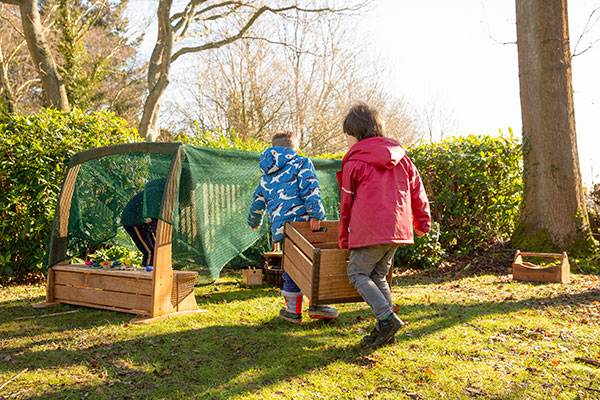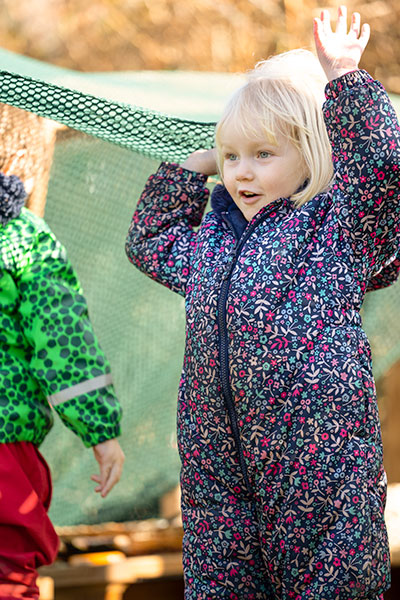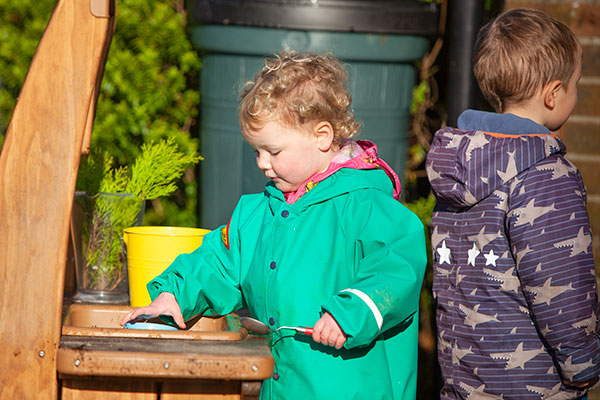Outdoor play for children
| June 2012Everyone who works with young children in early childhood programmes and schools knows how quickly bacteria and viruses spread in these environments. One way to reduce the spread of infection is through lots and lots of fresh air. Outdoor play enables the infectious agents to spread out and be dissipated; it also enables children to get fresh air and exercise and be less constrained than they are in the classroom (Aronson, 2002).
Outdoor play also enables children to enjoy the natural environment and learn to seek out exercise, fresh air, and activity. There is something fundamentally healthy about using the outdoors. Thus outdoor play develops disposition for the outdoors, for physical activity, and for care of the environment. Children who engage in lots of physical activities at school tend to engage in more energetic activities at home, while children who have childcare and school experiences that lack active physical activity, engage in more sedentary behaviours at home, such as watching TV and computer use (Dale, Corbin, & Dale, 2000). Children who learn to enjoy the outdoors have a much higher likelihood of becoming adults who enjoy hiking, gardening, jogging, bicycling, mountain climbing, or other outdoor endeavours. This is critical as obesity becomes an ever-greater national concern and as we must all learn to care for and protect the environment.
Allowing children to be children
Using open space to fulfil basic childhood needs – jumping, running, climbing, swinging, racing, yelling, rolling, hiding, and making a big mess – is what childhood is all about! For a variety of obvious reasons many of these things cannot occur indoors. Yet children must have these important experiences. Today children’s lives are more and more contained and controlled by small apartments; high-stakes academic instruction; schedules; tense, tired, and overworked parents; and by fewer opportunities to be children. Outdoor environments fulfil children’s basic needs for freedom, adventure, experimentation, risk-taking, and just being children (Greenman, 1993).
Children need the opportunity to explore the unknown, the unpredictable, and the adventurous. They also need to be able to wonder at nature, from the worm gliding through the newly turned dirt in the garden to the monarch butterfly emerging out of the chrysalis and gracefully fluttering away in the summer breeze.
Encouraging different kinds of play
Physical play
In general, physical play should be encouraged by climbing equipment and swings (also in the toddler area), tricycle paths, and large areas of grass and hills on which pre-schoolers can run and crawl and infants and toddlers can lie, crawl, and roll. Tricycle paths are used for Big Toys, tricycles, scooters, balls, jogging, and wagons. Climbing equipment for infants and toddlers should be very basic, including a crawling tunnel, small steps, and a slide. Because toddlers are very insecure on their feet, special attention should be paid to barriers – the railings and sides of raised equipment. A variety of sloped areas help children learn to adjust their balance on differing surfaces. Although it is important to encourage specific motor skills such as fine and gross motor development, it is more important to support the development of the brain and nerve functions and growth. Thus rolling, crawling, running and climbing, and swinging on swings are all absolutely critical activities for young children.
Constructive play
Research continually shows that constructive play is the pre-schoolers’ favourite kind of play, probably because they can and do control it (Ihn, 1998). Constructive play is encouraged by using sand and water play, providing a place for art, woodwork and blocks, wheeled toys, and lots of loose objects throughout the playground. Constructive play occurs in sandboxes, in sand and water areas, on flat surfaces, even on grass (Wardle, 1994).
Social play
Children need lots of opportunities outside to develop basic social skills and social competencies: pushing each other on the swing, pulling a wagon carrying another child, playing together in the sand, and so on. Clearly, physical play, constructive play, and sociodramatic play also involve social play, especially if the equipment encourages the engagement of more than one child. Projects such as gardening, observing the weather in a separate science area, and having a picnic can be – and should be – social activities.
Sociodramatic play
A good playground must have playhouses, forts, and other structures that children can change, adapt, reconfigure, impose their own meaning on, and use to expand their imagination. These structures encourage rich sociodramatic play; further, they are an ideal place for the playground to reflect the cultures of the children who use it.
Dramatic play requires children to impose details, information, and meaning into their play. It is richer and more beneficial because they do so and dramatic play structures should be very simple and basic in design and construction. A basic structure of four walls, a roof, and a window can be the children’s home, a classroom, a doctor’s office, or a castle. On the other hand, a realistic replica of a 7-11 convenience store can only be a 7-11, and a rocket can only be a rocket (Wardle, 2003a).
Games with Rules
The well-known games of Drop the Hanky, Red Light – Green Light, Simon Says, and Follow the Leader, are all simple games with rules, the highest level of cognitive play (Piaget, 1962). Children need places outside to play these games, and to “all fall down” is much more pleasant on grass than on concrete.
Outdoor play advocacy
According to Sutterby and Frost (2002FD), too many educators, politicians, and parents believe outdoor play takes time away from academic activities. As a result recess and physical education in many schools is limited or totally eliminated. Further, programmes that do advocate outdoor play often focus on learning cognitive and academic skills, rather than encouraging needed physical pursuits and social interactions. Major reasons for this problem is the adoption of academic standards by many state departments of education, the move to accountability, and the Bush administration’s No Child Left Behind initiative.
However, there is a growing number of people and organisations that are attempting to reverse this trend. They include IPA and IPA USA, People C.A.R.E., and countless individual teachers, professors, writers, and ordinary parents.
Summary
Providing for the outdoor play needs of young children is a complex and challenging task. A variety of factors must be considered, including the various play needs of young children, supervision, safety, and ADA access. However, because our children experience fewer and fewer opportunities to explore nature, run, roll, climb, and swing and because outdoor play is part of being a child, we must find a variety of ways to provide quality outdoor play experiences for children, infants through age eight years. This task is made even more important as our early childhood programmes focus more and more on teaching basic skills and early academics.
From Johnson, Christie & Wardle; Play, Development and Early Education, published by Allyn and Bacon, Boston, MA. Copyright (c) 2005 by Pearson Education. Reprinted by permission of the publisher.










